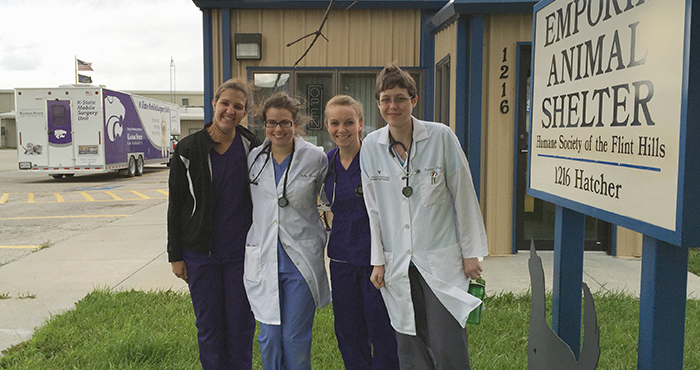The K-State Shelter Medicine Program provides veterinary services in areas with limited access to care.
Shelter medicine is where community service meets education. By providing veterinary care in areas where there are barriers to access, the program introduces students to the importance of community outreach within the veterinary field.
One of the main ways veterinary students can learn about shelter medicine and community outreach is through Kansas State University’s two mobile clinic units. In these units, fourth-year veterinary students serve as the lead ‘doctors’ of the clinic with second- and third-year students supporting them on two-week rotations.
The units travel to locations in Kansas, Nebraska and South Dakota, visiting a variety of animal welfare organizations. The program helps to address the shortage of rural veterinarians and the need for sufficient care for populations with many pet owners who are homeless or underserved. In these communities, veterinary students practice clinical skills, including surgeries, physical exams, vaccines, dental care and therapeutic planning. Not only do veterinary students bring needed care to these communities, but the support is offered with no consultation fee for regional shelters or pet owners.
“The ultimate goal is to directly raise the bar of care in the communities we serve and develop more skilled veterinarians in the process,” said Dr. Brad Crauer, an associate clinical professor in shelter medicine.
Over the past few decades, shelter medicine has grown in demand, especially as more shelters hire veterinarians. Shelter medicine is the newest specialty in the College of Veterinary Medicine.
Since the first shelter medicine truck and trailer were introduced in 2015, the rotation has quickly become the most popular among veterinary students. Each year, 92 vets-in-training participate in the shelter medicine rotation. Prior to this program, veterinary medicine students typically only performed a total of five spay/neuters during their four-year curriculum. During the two-week rotation, each student performs 40-50 spay/neuters. Increasing the number of procedures performed by students gives them greater confidence, vastly improved knowledge and hands-on skills, and helps them to be more ready for practice when they graduate.
While the mobile clinic units are important in helping students learn practical veterinary skills, Dr. Crauer says students benefit most from their exposure to service-based venues. Students get to learn more about local animal welfare organizations, while simultaneously gaining an understanding of socio-economically diverse populations.
K-State’s shelter medicine offerings are a point of pride for the College of Veterinary Medicine, establishing K-State as a leader nationwide and attracting prospective students to the program. Almost entirely funded by private donations, grants and corporate sponsors, philanthropy is essential to the $400,000 annual operating budget for the Shelter Medicine/Community Outreach Program.
Every dollar makes a difference — $5,000 toward the mobile clinic unit can sponsor the resources for five weekend outreach trips. With such incredible impact from donations, students learn about responsible resource management by helping to manage supplies for the mobile units.
“We have an amazing impact on a daily basis, but it is so dependent on outside support,” Dr. Crauer said. “We are on the front edge of a rapidly developing industry focused on raising the bar of care for people and pets with access barriers.”
